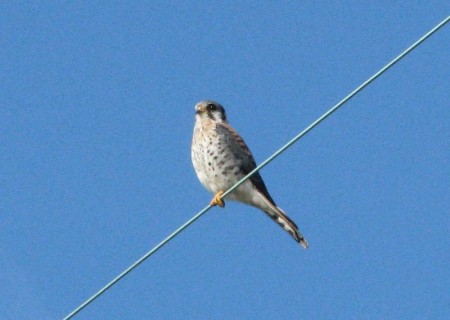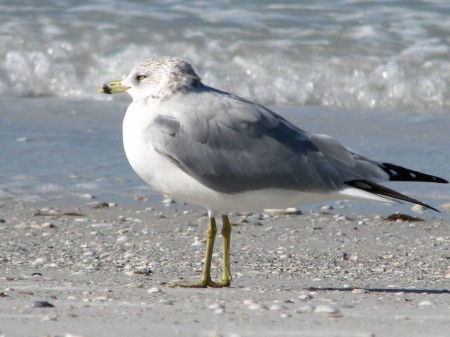Posted by David McRee at BlogTheBeach.com
I developed a strong interest in birds when I was perhaps 6 or 7 years old. They’ve always fascinated me. I learned to identify hundreds of local species by the time I was 14. Then life happened and several decades passed where looking for birds just wasn’t on my schedule. Now that’s beginning to change.
Since I’ve started looking for birds again I’ve noticed that many things have changed. “Birdwatching,” for instance, has now become “birding.” What used to be an activity for boy scouts and nerdy scientists has now attained a bit of a “coolness” factor. Now even chicks dig birding.

The American Kestrel (previously known as the Sparrow Hawk) perches on a wire near North Beach at Fort Desoto County Park in Pinellas County, FL.
The most unsettling change is in the names of the birds. My first discovery of a name change was when I saw what I remembered to be a Marsh Hawk on Pine Island. I looked it up in my new Sibley Field Guide just to be sure. Couldn’t find it. But it looked surprisingly similar to the “Northern Harrier” pictured in the guide. I had to resort to Google to find out that the Marsh Hawk is now officially referred to as the Northern Harrier (since 1982). What? I’m in Florida. How much further south can I go in the states? And I have to call it a NORTHERN harrier? No thanks. To me it’s still a Marsh Hawk.
Here are a few other name changes and the date they were put into effect:
- The Common Crow became the American Crow in 1982
- The Sparrow Hawk became the American Kestrel in 1973 (more regal, no?)
- The Common Egret became the Great Egret in 1973 (but don’t confuse it with the Great White Heron)
- The Common Gallinule became the Common Moorhen in 1982
- The Everglade Kite became the Snail Kite in 1982
1973 and 1982 seem to have been important years for bird name changes. I’m sure there’s a good reason, and I’m sure the American Birding Association and the American Ornithologists’ Union could fill me in on all the details. I’ve obviously got lots of catching up to do.
That’s one of the reasons I’m looking forward to the 13th Annual Space Coast Birding and Wildlife Festival coming up in January 2010. It’s an event where I can connect with birders from all over the world and learn from some of today’s most respected birders, ornithologists and photographers.
I’m going to be blogging a lot about the Birding and Wildlife Festival. In fact, I’ll be live-blogging from the event for 5 days beginning January 28, 2010, so look forward to a lot more information over the next few months as I dig into the details of the classes and field trips offered and of the speakers and presenters.
This year the North American Gull Conference will be held in conjuction with the Birding Festival, so it looks like I’ll be learning a lot about gulls. Gulls are some of the most graceful birds in flight, and some of the most challenging birds when it comes to sorting out the various species and plumages.




